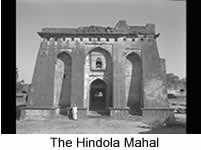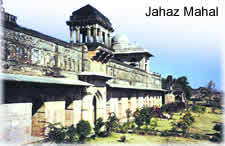
Dimdima
Online Children's Magazine from India

Dimdima
Online Children's Magazine from India

The hill-fort of Mandu is separated from the main plateau of Malwa by Kakra Khoh, a deep ravine. You can enter the fort city through any one of its arched gates : Alamgir Gate, Bhangi Gate, Karnani Gate and the Gada Gate.
Many of the monuments Mandu was once famous for, are now in a state of ruin. The Nahar Jharokha or the Tiger Balcony once served as the place for kings to address their subjects. Emperor Jahangir conferred the title of Shah Jahan or king of the universe upon his son Prince Khurram here. In the vicinity of the balcony is the Champa Baori, a well whose sweet water has the fragrance of the champa flower.
Mandu has a few monuments that have withstood the test of time. One such monument is Dilawar Khanís Mosque, which is the earliest Indo-Islamic structure in the region. It was built by Dilawar Khan, the founder of the Ghuri dynasty.
 The Hindola Mahal and the Jahaz Mahal in Manduís royal enclave, are architectural wonders. Both palaces were built by Sultan Ghiyas-ud-din Khilji. The Hindola Mahal or the Swinging Palace got its name because of its peculiarly sloping side walls. The Jahaz Mahal, as its name suggests, is a palace that gives the impression of an anchored ship. Close to the market place is the tomb of Hoshang Shah, son of Dilawar Khan. It is Indiaís first marble edifice. Shah Jahan is believed to have sent his architects to Mandu to study this tomb before designing the Taj Mahal.
The Hindola Mahal and the Jahaz Mahal in Manduís royal enclave, are architectural wonders. Both palaces were built by Sultan Ghiyas-ud-din Khilji. The Hindola Mahal or the Swinging Palace got its name because of its peculiarly sloping side walls. The Jahaz Mahal, as its name suggests, is a palace that gives the impression of an anchored ship. Close to the market place is the tomb of Hoshang Shah, son of Dilawar Khan. It is Indiaís first marble edifice. Shah Jahan is believed to have sent his architects to Mandu to study this tomb before designing the Taj Mahal.
The most romantic place in Mandu, is the Roopmati Pavilion, the palace Sultan Baz Bahadur (the regionís last Pathan ruler) built for his lovely Hindu consort, Roopmati. It stands on top of a hill. The lovers met with a tragic end. When Baz Bahadur was defeated by the Mughal army, he left Roopmati behind. The hapless lady consumed poison, preferring death to separation. Roopmati was buried by the side of Baz Bahadur in a tomb in Sarangpur.
Roopmatiís pavilion overlooks Baz Bahadurís palace and the gently flowing Narmada, in the Nimar plains far below. It was from this pavillion that Roopmati used to offer her prayers to the sacred Narmada.
| Ruins of rock-cut Buddhist shrines and monastries dating back to the 4th and 5th centuries AD nestle in the southern slopes of the Vindhyas, in the Narmada valley. They are called Bagha Gompha because they became a tigersí haunt after the monks left. The caves were rediscovered only two centuries ago. Gross neglect have played havoc to the wall paintings, that once compared only with the paintings at Ajanta and Ellora. |
Last updated on :12/5/2005
Dimdima is the Sanskrit word for ‚Äėdrumbeat‚Äô. In olden days, victory in battle was heralded by the beat of drums or any important news to be conveyed to the people used to be accompanied with drumbeats.
Bharatiya Vidya Bhavan
K. M Munshi Marg,
Chowpatty, Mumbai - 400 007
email : editor@dimdima.com
Bharatiya Vidya Bhavan
505, Sane Guruji Marg,
Tardeo, Mumbai - 400 034
email : promo@dimdima.com
Dimdima.com, the Children's Website of Bharatiya Vidya Bhavan launched in 2000 and came out with a Printed version of Dimdima Magazine in 2004. At present the Printed Version have more than 35,000 subscribers from India and Abroad.